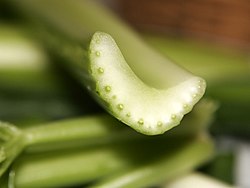Vascular tissue


Vascular tissue is a complex conducting tissue, formed of more than one cell type, found in vascular plants. The primary components of vascular tissue are the xylem and phloem. These two tissues transport fluid and nutrients internally. There are also two meristems associated with vascular tissue: the vascular cambium and the cork cambium. All the vascular tissues within a particular plant together constitute the vascular tissue system of that plant.
The cells in vascular tissue are typically long and slender. Since the xylem and phloem function in the conduction of water, minerals, and nutrients throughout the plant, it is not surprising that their form should be similar to pipes. The individual cells of phloem are connected end-to-end, just as the sections of a pipe might be. As the plant grows, new vascular tissue
Between the xylem and phloem is a
In leaves, the vascular bundles are located among the spongy mesophyll. The xylem is oriented toward the adaxial surface of the leaf (usually the upper side), and phloem is oriented toward the abaxial surface of the leaf. This is why aphids are typically found on the undersides of the leaves rather than on the top, since the phloem transports sugars manufactured by the plant and they are closer to the lower surface.[citation needed]
See also
External links
- Intro to Plant Structure Contains diagrams of the plant tissues, listed as an outline.
